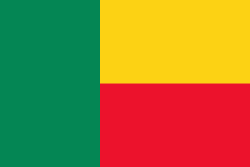Parakou
Parakou is the largest city in northern Benin, with an estimated population of around 206,667 people, and capital of the Borgou Department. Administratively the commune of Parakou makes up one of Benin's 77 communes. Since 2015, its mayor is Souradjou Adamou Karimou.
The city was founded in the 16th century by traders. Among traders there is a first occupant of the Old City, a hunter named sina kpebiegi. This hunter was from baatonou community. Even the traditional leaders are living from slaves trade the population are living from fishing and agriculture.
The city was founded in the 16th century by traders. Among traders there is a first occupant of the Old City, a hunter named sina kpebiegi. This hunter was from baatonou community. Even the traditional leaders are living from slaves trade the population are living from fishing and agriculture.
Map - Parakou
Map
Country - Benin
 |
 |
| Flag of Benin | |
From the 17th to the 19th century, political entities in the area included the Kingdom of Dahomey, the city-state of Porto-Novo, and other states to the north. This region was referred to as the Slave Coast from the early 17th century due to the high number of people who were sold and trafficked during the Atlantic slave trade to the New World. France took over the territory in 1894, incorporating it into French West Africa as French Dahomey. In 1960, Dahomey gained full independence from France. As a sovereign state, Benin has had democratic governments, military coups, and military governments. A self-described Marxist–Leninist state called the People's Republic of Benin existed between 1975 and 1990. In 1991, it was replaced by the multi-party Republic of Benin.
Currency / Language
| ISO | Currency | Symbol | Significant figures |
|---|---|---|---|
| XOF | West African CFA franc | Fr | 0 |
| ISO | Language |
|---|---|
| FR | French language |















